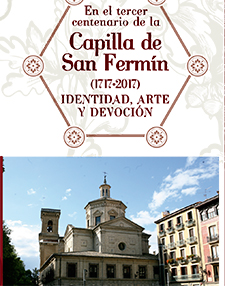On the third centenary of the
Chapel of San Fermín (1717-2017)
IDENTITY, ART AND DEVOTION
12 September 2017
The multiplied image of Pamplona and other representations of San Fermín in Navarre
D. Ricardo Fernández Gracia. Chair of Heritage and Art of Navarre.
The presence of San Fermin in images and paintings in Navarre had a great increase from the first half of the 17th century, under the protection of the confrontation between Ferminists and Xavierists. The Salomonic papal decision of 1657 propitiated the presence of both as co-patrons and the image of the bust of the parish of San Lorenzo, as an icon of reference letter in the representations of the saint, multiplied thanks to the engraved prints, especially during the XVIII century.
Between legend and reality
As on so many other occasions, in the case of San Fermín it was the religious feast that brought with it the recreational and celebratory diversions that have been changing over the course of history. In plenary session of the Executive Council XII century -1186- the bishop of Pamplona, Pedro de Paris, collected the relics in Amiens and arranged that his feast, which was already celebrated, had the same rank as that of the apostles. Later, in 1445, the feast and its octave were extended to the entire diocese, although the altar of the saint, venerated in the cathedral, was only popular in Pamplona and the feast in his honor was celebrated on October 10. In 1591 the city of Pamplona asked the bishop to transfer the feast to July 7, a request that was granted. This was the beginning of the current festivities, which, over time, have accumulated a plurality of components and anthropological functions. The Sanfermines that we know today are the sum and condensation of traditions, customs, habits and diverse phenomena from different periods.
According to legendary tradition, San Fermín was the first bishop of Pamplona, although his cult is not documented until the 12th century, when it was imported from the French city of Amiens. In the martyrologies of the 9th century, there is a record of a martyred San Fermín in Amiens who, according to some, would also be its first bishop. His feast was celebrated on September 25, the day of the commemoration of his martyrdom. At the end of the X beginning of the 11th century, a version of doubtful historical foundation crystallized, according to which Fermin was the son of the senator of Roman Pamplona. His conversion to Christianity was due to Honestus, a disciple of Saint Saturninus. Consecrated bishop at the age of 24, he went to evangelize Gaul and after preaching in Ager, Clermont, Angers and Beauvois, he suffered martyrdom in Amiens, after baptizing thousands of people. The saint is celebrated on September 25 (martyrdom), January 13 (invention of his relics), October 10entrance in Amiens) and July 7 as his own feast day in Pamplona.
The saint is co-patron saint of Navarre together with St. Francis Xavier since 1657, by decision of Pope Alexander VII, after a long bloodless war between ferministas and javieristas that confronted in Navarre institutions and peoples in favor of one and the other saint. In plenary session of the Executive Council period of Catholic Reform, when there were renewed ideals of sanctity, the Deputation of the Kingdom of Navarre, in 1621, received Javier as patron saint , proposing that the Cortes, as an institution that embodied the Kingdom itself, ratify the board of trustees, something that happened in 1624. Lawsuits over patronages were frequent in Spain in the sixteenth century, especially in the case of Santiago and Santa Teresa. In Navarre, the Xavierists, strongly influenced by the Jesuits, were supported by the institutions of the Kingdom -Cortes and Diputación-, whose members included former students of the Society, while the Ferminists were supported by the city of Pamplona and the chapter of its cathedral, together with a clergy quite suspicious of the power and influence that the sons of St. Ignatius were assuming. The differences between the two sides became more acute in 1643, when the Diputación published a proclamation declaring that the only patron saint of the Kingdom was San Francisco Javier. The lawsuit reached the Roman Curia and ended with a Papal Brief in 1657, by which San Fermin and San Francisco Javier were declared the principal patrons of the Kingdom.
The image of San Fermín is, without a doubt, one of the images most identified outside these lands with Navarre and especially with its capital, Pamplona. In the diffusion of his image and iconography played an extraordinary role, in Madrid, the Royal Congregation of San Fermín of the Navarrese established in the convent of the Minim and later in the convent of the Trinitarians, to end up having its own headquarters in the Paseo del Prado. However, it was Pamplona, the city that distinguished itself throughout this period by an unprecedented zeal to maintain and increase the cult of the saint, with the construction of the chapel in the parish of San Lorenzo between 1696 and 1717 as the most important event and the realization of great civic and religious festivities to celebrate his feast days.
The iconographic characterization of San Fermín is very simple, a bishop with episcopal vestments, ring, crosier and with the mitre and the pluvial cape of red color alluding to his martyrdom. The dark face will not be exclusive to his well-known reliquary bust in his chapel, his official image, but will be repeated in numerous sculptures scattered throughout the entire region. Regarding the iconographic types, we only have the isolated image as a holy bishop and scarce representations of martyrdom.
Devotional prints
Devotional engravings constituted, in times past, a fundamental means of spreading devotions, since for a modest price one could satisfy the desire to empalize with some icons from reference letter. In the case of San Fermín of the parish of San Lorenzo, a somewhat free version of the same before its baroque style is the engraving that illustrates the Constitutions of the Royal Congregation of San Fermín de los Navarros, a work of Juan Francisco Leonardo from 1684 and that, apparently, was also thrown aside. This engraver reproduces a reliquary bust more elongated than the Pamplona model and with the reliquary arranged horizontally with respect to its axis, instead of vertically.
The first loose print as such was made by the silversmith Fermín Galindo at the end of the 17th century and reproduces the bust of the parish of San Lorenzo. It must not have been profusely thrown away and the only known copy is kept at the Library Services Nacional de Madrid.
Another even freer version and in a clear attitude of declamatory gesture typically baroque offers the engraving of Bernard Picart made in 1714, whose plate was given by Don Norberto de Arizcun to the city council of Pamplona to print as many images as necessary and the city council adopted it as the official image of the saint, by preventing, by agreement municipal of 1715 to all the printers of the city that whenever they needed to take portraits of the saint patron saint they should do it with the mentioned plate. Its success was B and the prints were used at different times by the Pamplona authorities to request funds and prizes for the adornment of the chapel. On occasion, silks and silks destined for civil and ecclesiastical authorities were printed. In addition, its plate would be copied literally by an Aragonese engraver B in 1798, at the expense of a discalced Carmelite nun.
In 1721 the silversmith established in Pamplona, Juan de la Cruz, opened a plate dedicated to the Virgen del Camino. In its lower part appear San Fermín and San Saturnino. It was retouched on numerous occasions and served as model for canvases and other embroidered works in Navarre, Spain and even New Spain.
The engraver of the illustrations of the Annals of Navarre, in its Pamplona edition of 1766, José Lamarca made a large plate reproducing the throne of the saint in his chapel in 1756 that would serve as model for canvases, such as the one signed by Pedro Antonio de Rada of the Municipal file or the neoclassical version of the parish of Irañeta, signed by Miguel Sanz Benito in 1849.
Although they were not made in Navarre, it is necessary to mention, for their projection, the engraving plates that the Royal Congregation of San Fermín of the Navarrese ordered to be opened in Madrid in the 18th century to distinguished artists like Juan Bernabé Palomino, Manuel Espinosa or fray Matías de Irala, they present the saint in full body with his usual episcopal attire. In some cases, as in Palomino's print, the composition is completed with allegorical figures of converts, cripples and even in the background there is room for the saint's tomb, from which luminous lights attract various sick people.
Other images throughout the region
In comparison with the almost non-existent medieval iconography of the saint in these lands, among which the Gothic images of Olloqui and Acárate stand out, his images multiplied, starting in the 16th century, placing his sculptures and paintings making "pendant" with San Saturnino or other saints of traditional devotion and, more frequently, with San Francisco Javier, as a result of the declaration of the co-patronage for the whole Navarrese kingdom in 1657. The magnificent seated sculpture of the parish of Huarte-Araquil and that of the main altarpiece of the Dominicans of the capital of Navarre belong to the First Renaissance, as well as the paintings of Juan del Bosque in the old altarpiece of Burlada (today in the Museum of Navarre), in the altarpiece of San Eutropio de Ustárroz (1572), and the panels of the Oscáriz family in Eguiarreta and Berriosuso. More advanced in time and of invoice Romanesque is the sculpture of the old altarpiece of the cathedral of Pamplona, today in the parish of San Miguel of the same city.
However, among the isolated images, we must mention first of all the reliquary bust of his chapel in the parish of San Lorenzo de Pamplona. It is a simple wooden work from the beginning of the 16th century and polychromed in 1550, to which an oval teak reliquary in rich silver cartouche was added, the work of the silversmith Hernando de Oñate, in 1572. During the 17th and 18th centuries, the bust-reliquary acquired its present appearance. First, it was covered with silver sheets in 1687, in imitation of the most important medieval images and later, it was made with a very rich silver base, executed in 1736 by the silversmith of Pamplona Antonio Ripando, under the design of Carlos Casanova, engraver and future painter of the Chamber who was in Pamplona at that time and was a silversmith. Finally, in 1787, the fire-gilded bronze angels were added, which gave the passage more color, contrasting the tones of silver, gold and red of his episcopal attire framing his dark complexion. From agreement with this same arrangement of bust-reliquary, the cathedral of Pamplona has a silver bust and the basilica of San Fermín de Aldapa another one of polychrome wood of inferior quality.
Among the sculptural images we must mention the one that presides over the altarpiece of his dedication in the ambulatory of the cathedral, commissioned by the archdeacon of the table Don Andrés de Apeztegui (1713), the altarpiece of the chapel of the episcopal palace of Pamplona (1748) or the altarpiece of Santa Catalina de Lesaca (1786).
Likewise, there are numerous canvases of different quality and chronology, almost all from the XVII century, many of them painted to commemorate the co-patronage or previous ones where the holy bishop appears with the coat of arms of Navarre. Among them, we can mention those of the Episcopal Palace, City Hall and Recoletas of Pamplona, the latter coming from the Bernardas de Lazcano or those of the Comendadoras de Puente la Reina.
Co-patron saint with St. Francis Xavier
The images of the co-patrons of Navarre must be contextualized in plenary session of the Executive Council period of Catholic Reform, when there were renewed ideals of sanctity and the Deputation of the Kingdom of Navarre, in 1621, received Javier as patron saint , proposing that the Cortes, as an institution that embodied the Kingdom itself, ratify the board of trustees, something that happened in 1624. Lawsuits over patronages were frequent in Spain in the sixteenth century, especially in the case of Santiago and Santa Teresa. In Navarre, the Xavierists, strongly influenced by the Jesuits, were supported by the institutions of the Kingdom -Cortes and Diputación-, whose members included former students of the Society, while the Ferminists were supported by the city of Pamplona and the chapter of its cathedral, together with a clergy quite suspicious of the power and influence that the sons of St. Ignatius were assuming.
The differences between the two sides became more acute in 1643, when the Diputación published a proclamation declaring that the only patron saint of the Kingdom was San Francisco Javier. The lawsuit reached the Roman Curia and ended with a Papal Brief in 1657, by which San Fermin and San Francisco Javier were declared the principal patron saints of the Kingdom. The festive celebrations of all subject, of religious and ludic character replaced the confrontations with some of the biggest celebrations that Navarre lived in all its history.
Most of the major altarpieces of the parishes present both saints. Medals, engravings and paintings are also frequent in the territory. In some cases the iconography of the co-patron saints was made in the Americas.
The hypothetical first and early sample of this iconography, the most particular of Navarre, for uniting its two patrons, is a canvas that is conserved in the municipal file of Pamplona and is suspiciously dated in 1629, almost fifty years before both saints were declared as patrons of the Kingdom. Another painting conserved in the City Hall of Pamplona dated 1657 and made by Juan Andrés Armendáriz, a well-known polychromator, is a good sample of other canvases that must have been made in the capital of the Kingdom on the occasion of the papal sanction of the double board of trustees of Navarre.
Among the works that, due to their character of book cover, reached an enormous diffusion and served for model to sculptors and painters, we have to mention two prints that accompany two works of Father Moret, chronicler of the kingdom and author of his famous Annals ( 1684) and Historical Investigations of the Antiquities of the Kingdom of Navarre ( 1665).
With San Fermín appears San Francisco Javier in the altarpiece of San Jerónimo of the cathedral of Pamplona, although not making pendant in the same body, but superimposed in the same street. The carvings of the main altarpieces of Larraga and Miranda de Arga, works of Fermín de Larrainzar and José de San Juan y Martín, correspond to the end of the XVII century. Both were replaced by other modern ones. Shortly after, in 1703, the bultos of San Fermín and San Francisco Javier of the main altarpiece of Arizcun, work of the sculptor Miguel Sagüés, were dated. The sculptures of the parish of Eulate will be dated together with its main altarpiece, of which they are part, made from 1713 by the master Pascual de Oráa, although it was modified at the end of the 18th century. The carvings of the Ciordia altarpiece were carved by the Estella resident master Francisco Sainz de Baraona from 1717 onwards, together with other dedications linked to local devotions. In Lumbier, both appear in the attic of the altarpiece and the carving of San Francisco Javier was executed in 1716 by the Aragonese Francisco Bosqued.
Very interesting from the point of view of iconographic program is the altarpiece of Santa Teresa of the abbey church of Fitero, work of José Serrano of 1730, paid for by the guild of the espadrilles. In it, together with the patron saints of Navarre, the patron saints of the universal Church - St. Peter and St. Paul -, the patron saint of the town - St. Raymond the Abbot - and the patron saint of the guild, St. Teresa of Jesus, are given quotation . In the Benedictines of Corella, Baltasar de Gambarte, placed both saints on the side streets of the main altarpiece of his church, paid for, in 1741, with funds from Don José Armendáriz y Perurena, first Marquis of Castelfuerte, who had a sister in the aforementioned convent.
In the parish chapel of the Holy Spirit of the cathedral of Tudela we find them in the first section, under the groin vault in windows simulated in the walls, one in front of the other. During the second half of the 18th century, both saints shared the limelight in the side streets of many major altarpieces, such as those of Azpilcueta, Irurita and Echarri Aranaz. In the first two cases they are sculptures of courtly bearing, while in the third, the two carvings were entrusted to the masters Juan Antonio and Manuel Martín Ontañón in 1752. In the altarpiece of Santiago de Sangüesa, work of Nicolás Francisco Pejón, made between 1768 and 1770, we find the contemporary carvings of both saints.
The co-patrons were not lacking in places of special significance. In the cathedral, during the solemn feasts, the busts of San Fermín and San Francisco Javier were taken to the main altar. In Roncesvalles, at a moment that we cannot specify, the sculpture of Javier was placed to make pendant with San Fermín in the main altarpiece. In the sanctuary of Ujué, in an altarpiece that we know thanks to an engraving by Miguel Gamborino (ca. 1800) they appear next to the image of the Virgin. From the sanctuary of Ujué medals were distributed throughout the 18th century, made in gilded bronze and imported from Rome, on which the Virgin was depicted on the obverse and the co-patrons San Fermín and San Francisco Javier on the reverse. The arrival in the second half of the 18th century is documented in the sanctuary's account books. It was done through merchants established in the south of France. Later, at the end of the 18th century and the beginning of the following century, the medals were no longer imported, but were ordered from a "silversmith" in Tafalla.
In the treasury of San Fermín, in the parish of San Lorenzo de Pamplona, are a pair of silver sacras, made in Pamplona by the silversmith José Yábar in the third quarter of the 18th century. Among the decorative motifs of the rococo border are the coats of arms of Navarre and Pamplona, the five wounds and the co-patron saints San Fermin and San Francisco Javier. In both cases, the silversmith seems to have used medals minted in Rome years before. For San Fermín there seems to be no doubt in the model, specifically, it was one that years before had brought from Rome the archdeacon of the Chamber of the cathedral of Pamplona, at the beginning of the decade of the thirties of the XVIII century, in which the Virgin of the Tabernacle appeared on the obverse and San Fermín on the reverse. For St. Francis Xavier, possibly, there was an octagonal medal, also of Roman origin, which circulated widely among the saint's devotees.
Scanty scenes of his life
It is more rare to find scenes of his life in Spain, but not in France where he has many parishes and temples dedicated to him where they have been narrated since medieval times. At the head of all of them, the rich cycle of the cathedral of Amiens on its façade and in the choir. The scene of the martyrdom was recreated in a Renaissance relief of the main altarpiece of the Dominicans of Pamplona. Two canvases are preserved in the Pamplona consistory, one of large dimensions signed by José Ximénez Donoso in 1687 and another work by the local painter Mariano Sanz Benito from the end of the 18th century or the beginning of the following century, which is a transcription of the first one. Of popular character, but interesting from the iconographic point of view is the relief of the attic of the main altarpiece of Reta.
The eighteenth-century silver-plated pedestal reproduces in its reliefs some scenes from the life of the martyr and in the 1766 edition of the Annals of Navarre the finding and invention of his body are shown. To the XIX century corresponds the version of the martyrdom that the painter Alejandro Ferrán left us in the Throne Room of the palace of the Foral Deputation in 1865.
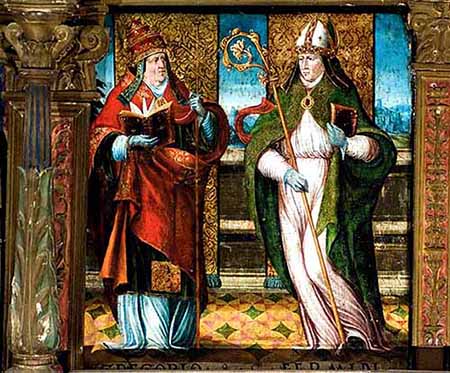
San Fermín and San Gregorio on a panel painted by Juan del Bosque (1540-46) from the Burlada altarpiece, now in the Museum of Navarre.
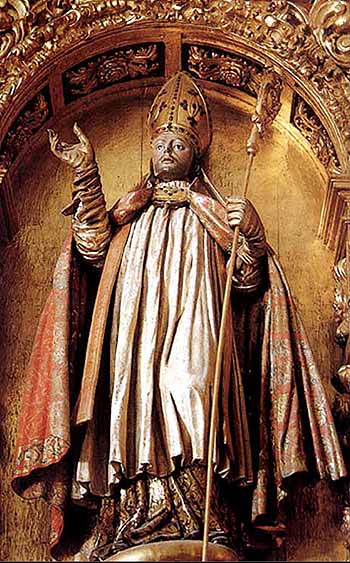
2.- Titular image of San Fermín in his altarpiece in the cathedral of Pamplona, 1713.
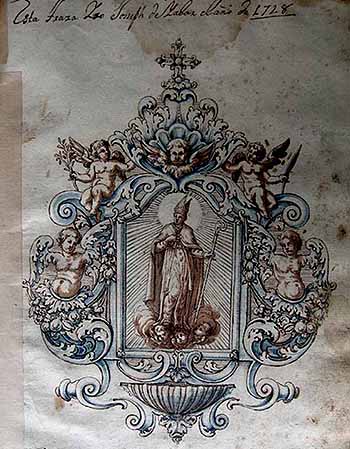
3.- San Fermín in the examination drawing by silversmith José Yábar, 1728.
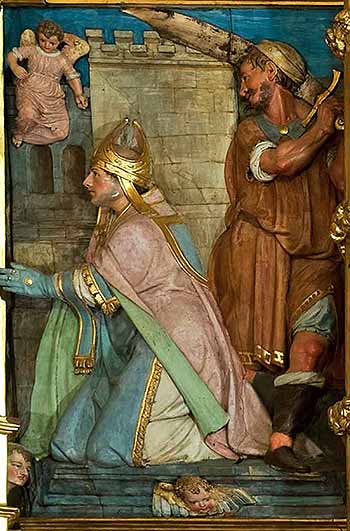
Relief of the martyrdom of San Fermín in the altarpiece of the Dominicans of Pamplona, 1570-74.
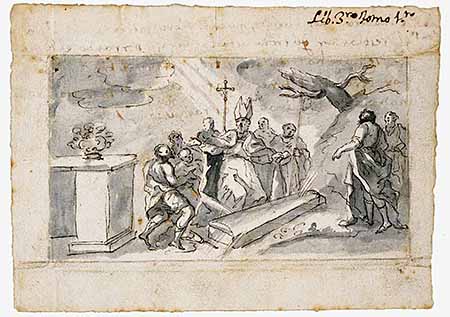
5.- Drawing of finding of the body of San Fermín by José Lamarca to engrave the corresponding plate in the illustrated edition of the Annals of Navarre, by Fr. Moret, 1766.

Reverse of the medal of the Virgin of Ujué with the co-patrons of Navarre following Roman models. End of the XVIII century
PROGRAM
Tuesday, 12th September
The baroque construction of the chapel
José Luis Molins Mugueta. Chair of Heritage and Art in Navarre
The multiplied image of Pamplona and other representations of San Fermín in Navarre
Ricardo Fernández Gracia. Chair of Heritage and Art in Navarre
Wednesday, 13 September
The academic reform of the chapel
José Luis Molins Mugueta. Chair of Navarrese Art and Heritage.
protocol and ceremonial around San Fermín
Alejandro Aranda Ruiz. Chair of Navarrese Heritage and Art
Thursday, 14th September
The treasure of San Fermín: pieces of liturgy and devotion
Ignacio Miguéliz Valcarlos. Chair of Navarrese Heritage and Art
The cult of San Fermín in the graphic collections of file Municipal of Pamplona
Ana Hueso Pérez. file Municipal of Pamplona

